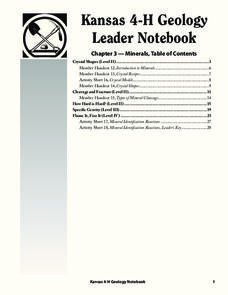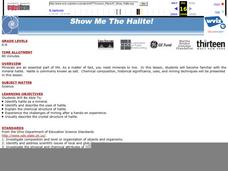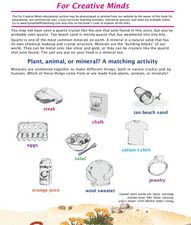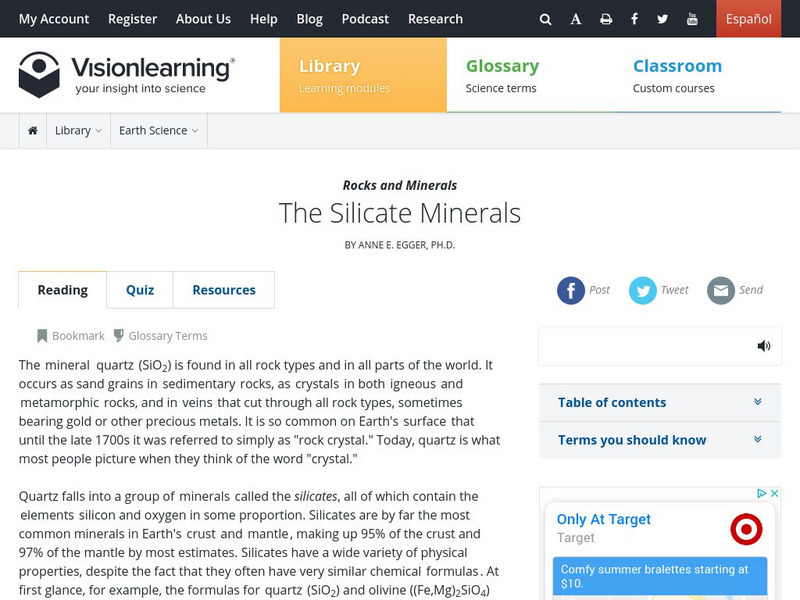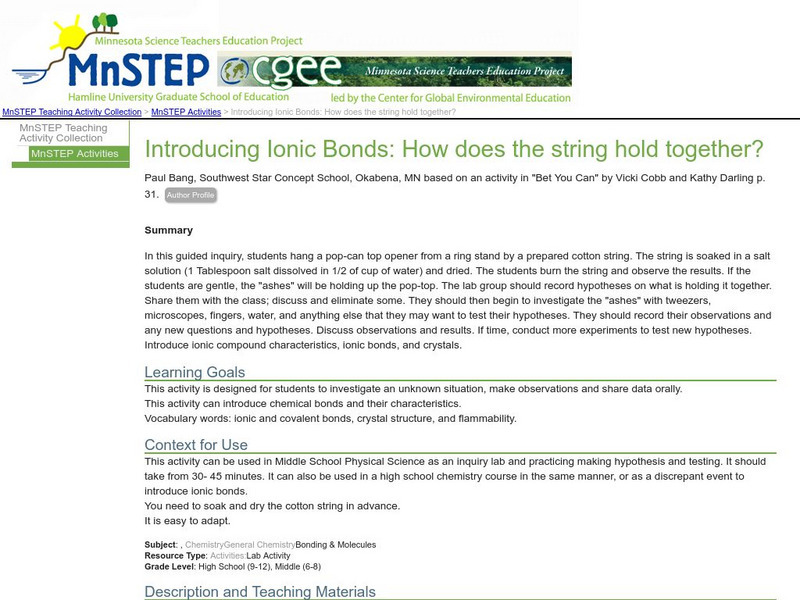Virginia Department of Education
A Crystal Lab
Young chemists grow ionic crystals, metallic crystals, and supersaturated crystals in three different lab experiments. Observing these under a microscope allows pupils to compare the various structures.
K-State Research and Extensions
Crystal Shapes
Of quartz I love geology! The chapter offers five activities at three different levels. It features hands-on activities that cover crystal shapes, cleavage and fracture, hardness scale, specific gravity, and mineral...
Institute of Electrical and Electronics Engineers
Sugar Crystal Challenge
Blow your learners' minds with a sweet lesson on nanotechnology that uses sugar to demonstrate the difference nanoscale surface area makes in dissolving and crystal formation. Plenty of supportive background information is read to...
American Museum of Natural History
Grow Rock Candy
The best way to study crystals is to make your own! A hands-on lesson shows learners how to make their own rock candy from household materials. While they watch the crystals grow, they discover their structure and can even eat their...
National Nanotechnology Infrastructure Network
Big vs. Little - Macro to Micro Lesson 5
It is a long way from nano to macro. Learners examined the scale of measurement from macro to nano in the first four lessons of the five-part series. With the final installment, they review what they learned by classifying objects in one...
National Nanotechnology Infrastructure Network
Wet Etching in Nanofabrication
Chemistry and physics combine forces to benefit nanofabrications. Learners examine the process of wet etching in nanofabrication. Using corrosive substances such as lemon juice and Coca-Cola, they model the etching process. They then...
National Institute of Open Schooling
Solid State
Crystal comes from a Greek word meaning ice. Activity eight in a series of 36 has class members analyzing amorphous and crystalline solids and further classifying them based on their forces. They then explore solids, learning about unit...
Normal Community High School
Crystalline Structure
Cubic crystals can have 6, 8, and even 12 sides. Here is a presentation that shows pupils three different kinds of cubic crystalline structures: cubic, body-centered, and face-centered. These structures are then applied to three...
Brooklyn Children’s Museum
Rocks and Minerals in Our Lives
Young geologists discover the important role that rocks and minerals play in our everyday lives through this series of hands-on activities. Starting off with a lesson that defines the difference between plants, animals, and...
Curated OER
Investigation of Crystallinity in Polymeric Materials
A kaleidoscope is constructed using polarizing polymer paper and then low-density polyethylene, high-density polyethylene, and polypropylene are all melted onto individual glass slides and examined through a microscope. The intent is to...
Curated OER
Crystal Ice Art
This isn't just an art instructional activity, it's a science instructional activity too. Kids draw a lovely winter scene and then paint over it with a solution of epsom salts and water. They make predictions, then observe how crystals...
Curated OER
Rocks and Minerals
Take young geologists on an exploration of the collection of rocks and minerals that we call Earth with an upper-elementary science lesson. Through a series of class discussion and hands-on investigations, students learn about the...
Curated OER
Chemistry Module
Students build metal atomic models using styrofoam. For this chemistry lesson, students identify the different unique properties of metals. They explain how metal atoms bond.
Curated OER
Introduction to Minerals
Young scholars discover how crystal structures go together to create minerals. In this earth science lesson, students work in groups to create 3-dimensional shapes of crystals that they then put together in a compact structure.
Curated OER
Nature's Polyhedrons
High schoolers discover the characteristics of polyhedra. Through hands-on activities and interactive videos, students investigate and retrieve information on polyhedra and crystal structures. High schoolers study angles and symmetry....
Curated OER
Show Me the Halite!
Introduce middle school mineralologists to halite. The opening of the activity involves a video and worksheet to which there are no links. However, you can replace the video with any informational clip that you can find online about...
Curated OER
For Creative Minds
Pupils study pictures of plants, animals, and minerals. Students classify the pictures into the three groups. In this rock identification lesson, pupils complete a rock finding lab experiment by finding, cleaning, identifying, and...
Georgia State University
Georgia State University: Hyper Physics: Geo Physics: Minerals
This is a resource for students to use in their study of minerals. It begins with a general description that includes the list of essential characteristics of a "mineral." Minerals are then grouped alphabetically. Selecting a name...
Vision Learning
Visionlearning: Earth Science: Minerals Iii: The Silicates
Instructional module focusing on the Silicate minerals. Discussion includes the most common minerals on Earth such as quartz, feldspar, mica, amphibole, pyroxene, and olivine. Site also includes an interactive practice quiz and links...
Vision Learning
Visionlearning: Earth Science: Minerals Ii: Properties
Instructional module focusing on the physical properties of minerals. Discussion includes the identifying characteristics such as color, hardness, luster, crystal forms, density, and cleavage. Site also includes an interactive practice...
University of Pennsylvania
University of Pennsylvania: Solid State Chemistry: Describing Crystalline Solids
This site contains in-depth information on crystalline solids. Includes basic concepts, pictures, learning graphs, and useful tools.
Vision Learning
Visionlearning: Earth Science: Rocks and Minerals: Defining Minerals
Instructional module focusing on minerals. Discussion includes chemical composition, chemical structure, and the formation process. The site also includes an interactive practice quiz and links relating to the topic.
Science Education Resource Center at Carleton College
Serc: Introducing Ionic Bonds: How Does the String Hold Together?
This inquiry activity introduces chemical and ionic bonds and allows students to investigate an unknown situation, make hypotheses, and share data.
Environmental Chemistry
Periodic Table of Elements: Gallium
A very detailed look at the element Gallium, a member of the Boron Group.



